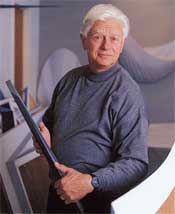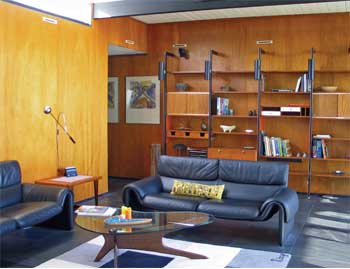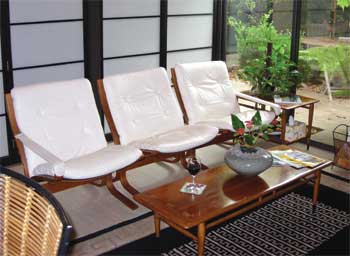Modern Furnishings - Page 2
 |
|
Outgrow your mistakes," says designer Matt Kahn. "It isyour house..." |
 |
|
|
 |
|
|
Kahn, often with wife and weaver Lyda Kahn, was an integral part of the original team responsible for selecting art and furnishings for Eichler's model homes. Their work can be seen in many vintage photographs captured by Ernie Braun, whose unforgettable images embellish Eichler's original marketing brochures.
"Eichlers are a proclamation of openness, originality, and permissiveness," says Kahn, pointing to the freedom of expression that Eichlers and homes of similar architecture provide. "If you make mistakes, then make them. Outgrow your mistakes. It is your house. The essential thing is the fundamental orientation towards purpose, and expression of that purpose. If what you put in your house does this, it belongs."
According to Kahn, Danish modern furniture of teak—in fact, many similar pieces are still manufactured today—were also part of the Eichler vocabulary and can work especially well against the original mahogany walls featured in many of these homes. "Such pieces made by Hans Wegner, shown alongside of Bertoia and Eames, as well as genuine Windsor chairs and Japanese Tansu chests, belonged together and worked together," Kahn points out.
So, does owning a mid-century modern home mean that its owner is 'aesthetically prohibited' from incorporating a beloved family heirloom into their home? Not necessarily, admit many professional designers—though they urge caution, planning, and organization as key success elements. One has to make an individual decision about how he or she wants to live in the home and what works best for them. Some may choose to create complete modernist havens that look as if they are from the pages of 'Dwell' or 'Metropolitan' Home magazine, while others may take a more eclectic approach. Yet these divergent methods can work, and they are not necessarily mutually exclusive.
Interior designers and architects can be helpful in guiding one through this process, and there are 'tricks of the trade' that can successfully and tastefully combine the old and the new, the modern and traditional. Most design professionals agree that it all comes down to organization without chaos, unification around a common theme or color, and developing a focal point.
While it was common for past generations to buy an entire matching set of furniture for the living room from a single source, many homeowners today have been liberated by eclecticism—taking chances by selecting individual pieces that work together. Contemporary designers encourage this approach and caution against taking the easy way out by giving in to the temptation of simply rolling over and saying, "I'll take that living room over there."
Vagn Jensen, owner of Danish Concepts of Mountain View, a showroom packed with lovely Scandinavian teak pieces, agrees with the cautious and deliberate approach to buying furniture. "Quality furniture lasts a long time, so it's important to take your time and get exactly what you like and will be happy with," he says. "I actually prefer that our customers begin by getting one piece, and living with it before they decide what else would fit in best."
Since open Eichler family and living rooms must often serve multiple purposes, most designers encourage homeowners to think about ways to organize their objects, textures, and colors into zones, or functional areas. Viewed from this perspective, Kahn likens furnishing a modern space to choreography, with a working interplay of objects and spaces.




